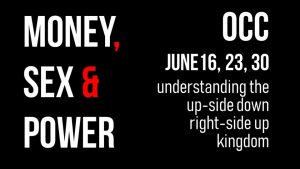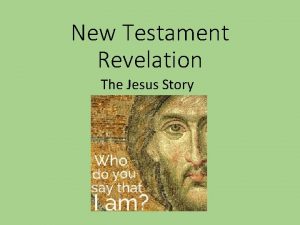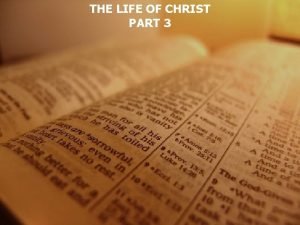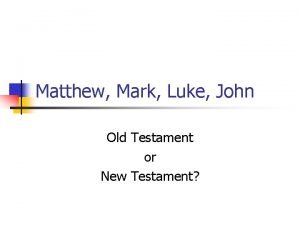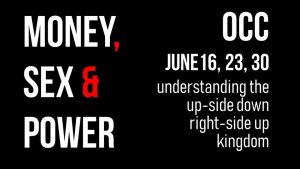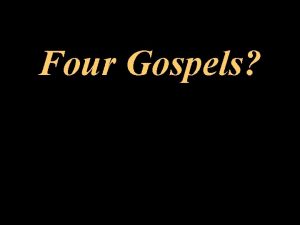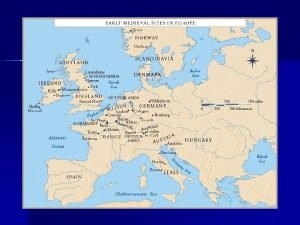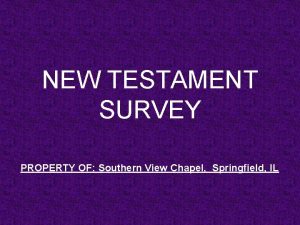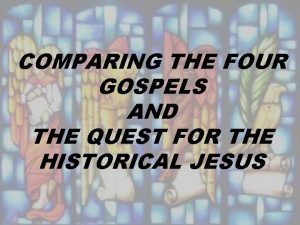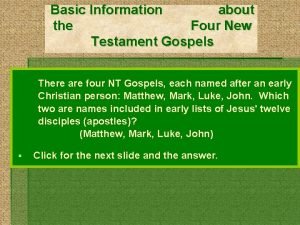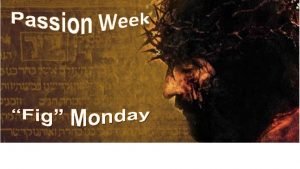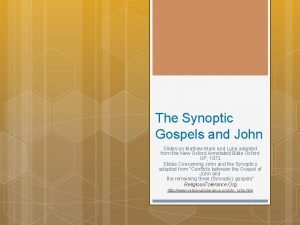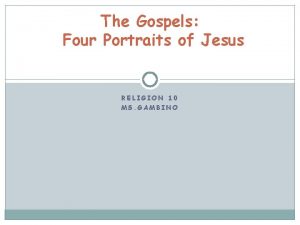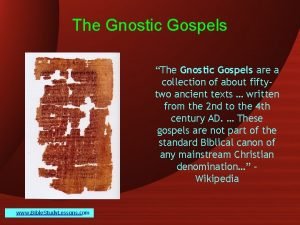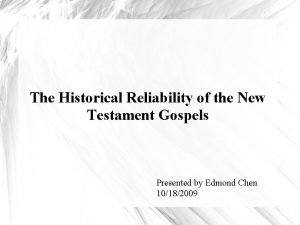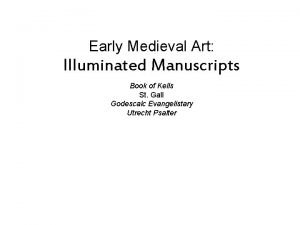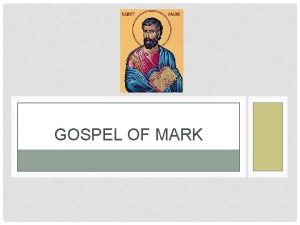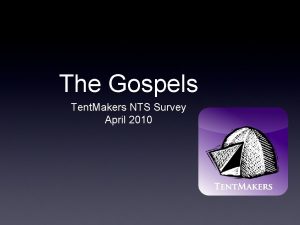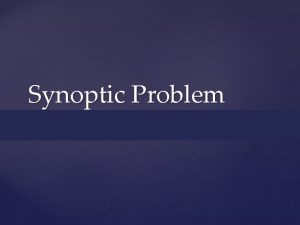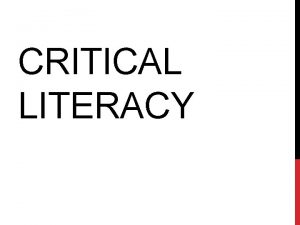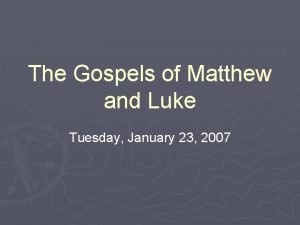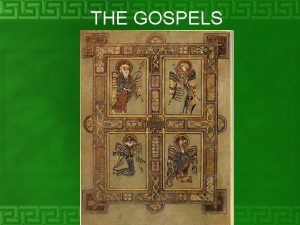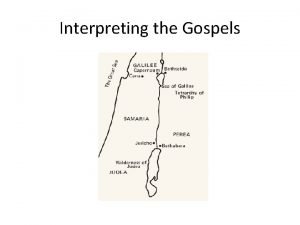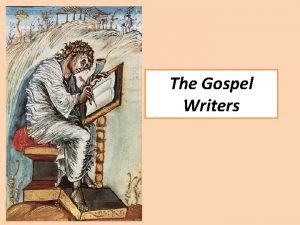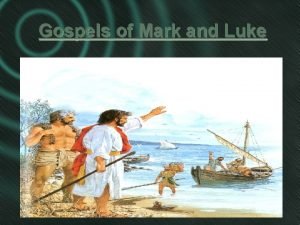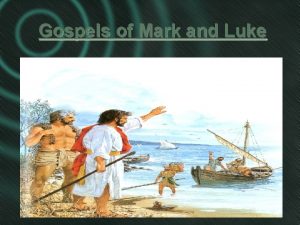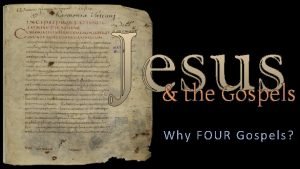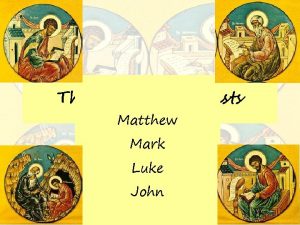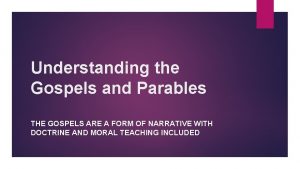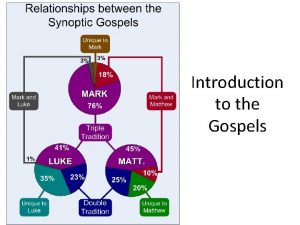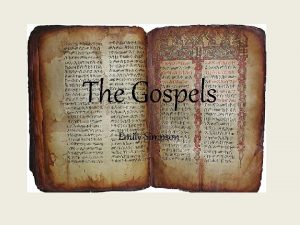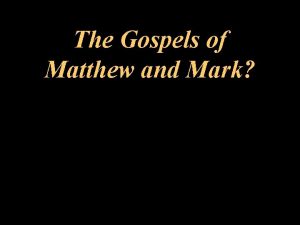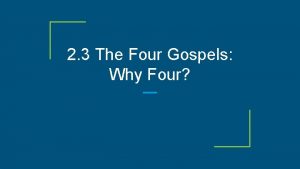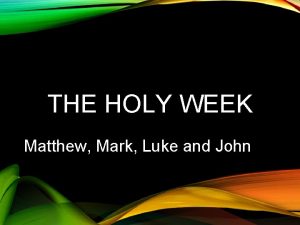The Four Gospels Matthew Mark Luke and John
























- Slides: 24

The Four Gospels: Matthew Mark, Luke, and John The Synoptic Gospels: Matthew

The Four Gospels: Matthew • Although Matthew is the first book in the New Testament, it probably wasn’t written first. • Records historic facts that form the basis of our faith. • Explains the details revealed about Christ’s earthly life. • “Good news” – Every valuable fact about Jesus learned ONLY from the gospels!

The Four Gospels • Events that paved the way for the spread of the gospel: – Career of Alexander the Great – Rise of the Roman Empire – Dispersion of the Jews • Greek gave the world unity of language. • Rome brought social order and roads on which to travel. • Scattering Jews undermined heathen religions.

The Four Gospels • The gospel was first preached in Jerusalem. • Preached in the Greek language. • Early Christians were scattered throughout the Roman world. – Inscription above the cross was in Hebrew, Greek, and Latin languages. – Testimony of Christ’s claims. He suffered to unite all nations into one family of God!

The Four Gospels • In many ways, Matthew, Mark, and Luke are alike, while at the same time being unlike John. • This is why Matthew, Mark, and Luke are called synoptic gospels. • The synoptic gospels dwell on Jesus’ ministry in Galilee; John features the ministry in Judea.

The Four Gospels • Matthew, Mark, and Luke tell us the detail of one of Jesus’ visits to Jerusalem—the one that ended with His crucifixion. • John records the four Jerusalem visits prior to that last one. – First three: miracles, parables, addresses to the multitudes—more objective – Fourth: emphasizes spiritual meaning and is more subjective

The Four Gospels • Each writer had a distinctive purpose in view. – Matthew 1: 1; Mark 1: 1; Luke 1: 1 -4; John 20: 30, 31 • Written gospel messages were preceded by the oral preaching of the messages. • Each gospel was directed toward a certain class of people. – Matthew primarily to the Jews – Mark wrote from the Roman point of view – Luke addressed the Greeks – John is sometimes called the universal gospel.

The Four Gospels • The Holy Spirit’s superintending and directing power prevailed in the selection of the contents of the books. – John 15: 26; 2 Peter 1: 20, 21 • Use of human personalities, experiences, and abilities, with Divine guidance from the Holy Spirit. • Books begin with Jesus’ birth; conclude with His ascension.

Matthew – the Author • Matthew was well-equipped for the task of writing to the Jews. • A tax collector under Herod Antipas • Knew his native tongue (Hebrew, or Aramaic) • Name changed from Levi to Matthew • Humble; referred to himself as a publican • Recorded no incidents concerning himself—a humble and retiring position

Matthew – When Written • First of the four gospels written • The church would need such a history from the pen of an actual apostle. • Must have predated the destruction of Jerusalem (Matthew 24) • Probably written between A. D. 55 and 68

Matthew – Purpose of His Gospel • A link between the Old and New Testaments. • Beginning of NT appropriate time for the Jewish reader. • Gospel of the Messiah—the anointed one. • To trace Christ’s genealogy back to Abraham.

Matthew – Purpose of His Gospel • Two-fold purpose: – To connect the message of the Old Testament with the gospel – To demonstrate the fulfillment of the Old-Testament prophecies through the coming of Jesus of Nazareth as the Messiah, the King.

Matthew – Calls Attention to… • Jesus as the Messiah, King – kingdom— 50 times – kingdom of heaven— 33 times – kingdom of God— 5 times – the King • Matthew 2: 2; 21: 5; 22: 11; 25: 34; 27: 11, 37, 42

Matthew – Calls Attention to… • Only Matthew traces Christ’s genealogy back to Abraham. • Matthew gives the story of the visit of the Magi who brought gifts to the newborn King. • Only Matthew refers to Jesus being born king of the Jews. • Only Matthew cites the prophecy of the ruler coming out of Bethlehem. • Only Matthew gives John the Baptist’s message, “the kingdom of heaven is at hand. ”

Matthew – Calls Attention to… • Christ’s kingship is asserted, confessed, and proven through fulfillment of prophecy. – Recognition of His person (Matt. 16: 13 -18) – Pronouncement of His authority (Matt. 28: 18 -20) – His claim that His teaching constituted law (Matt. 7: 24 -29) – Contrast between human genealogy and miraculous birth (Matt. 1)

Matthew – Calls Attention to… • All who were in His line of descendancy were transient, but He is eternal. (Hebrews 7: 23 -25) • All in His human lineage were sinful, but He lived without sin. • They were earthly; He was heavenly (second Adam). • They were Jews; He was God’s Son. (Jno. 1: 1 -11; Heb. 10: 5; Phil. 2: 5 -11)

Matthew – Gospel of Fulfillment • Cited 40 proof passages from OT – Genesis 12: 3; Galatians 3: 16; 2 Samuel 7: 12 • Some of the prophetic fulfillments: – Micah 5: 2 -place of birth (2: 1) – Isaiah 7: 14 -born of a virgin (1: 18 -23) – Jeremiah 31: 15 -massacre of infants (2: 16) – Hosea 11: 1 -flight into Egypt (2: 14, 15) – Zechariah 11: 12 -sold for 30 pieces of silver (26: 15)

Jesus, the Promised Messiah • Refers to OT scriptures with which the Jews were familiar. – “that it might be fulfilled which was written in the prophets, saying. . ” • Contrasts Christianity with the Pharisees’ concept of righteousness. • Words righteous and righteousness occur more often in Matthew than in the other three gospels combined!

Matthew – Sermon on the Mount • Sets forth spiritual principles of righteousness and the Kingdom of God. • Jesus affirmed regard for law. (5: 17) • Demanded a standard of righteousness far above the outward appearances of the Pharisees. (5: 20) • God, the perfect example. (5: 48) • Christ’s authority - superior to the authority of Moses. – “But I say unto you…”

Matthew – Sermon on the Mount • Differences in conformity; not just outward requirements—but requirements for the heart! • Obedience a must. (7: 21 -27) • God’s judgment against the Jewish nation and impending destruction in retribution for their unfaithfulness. (24) • Justice and righteousness part of God’s nature.

Matthew – Contents and Character • Introduction—(1: 1— 4: 11) – The genealogy – Jesus’ birth and childhood – Preparatory work of John the Baptist – Jesus’ baptism – Temptations in the wilderness

Matthew – Contents and Character • Jesus’ ministry—(4: 12— 16: 21) – Galilee, the starting place – Jesus’ words and acts – Sermon on the Mount and ten miracles – Sermon to the twelve—call to apostleship – His teaching—seven consecutive parables – Human traditions make void the word of God.

Matthew – Contents and Character • “From this time forth”—(16: 21— 21) – The Transfiguration (17: 1 -8) – The need for humility in the kingdom (18: 15 -20) – Open rejection from religious leaders – The rich young ruler (19: 16 -22) – Foretelling His suffering (20: 26 -28) – Triumphant entry into Jerusalem (21) – Rejection and unbelief (22)

Matthew – Contents and Character • Conflict with leaders, and death ending in victory—(23: 1— 28: 20) – Rebuking the hypocrites (23) – Foretelling Jerusalem’s destruction (24) – Parables-10 Virgins and Talents (25: 1 -30) – A glimpse into final judgment (25: 31 -46) – Plot to take His life and the betrayal (26) – Crucifixion (27) – Resurrection, ascension, and the Great Commission (28)
 Matthew mark luke john acts romans song
Matthew mark luke john acts romans song Are matthew mark luke and john the same story
Are matthew mark luke and john the same story Matthew mark luke john prayer
Matthew mark luke john prayer Matthew mark luke and john prayer
Matthew mark luke and john prayer Matthew mark luke john old testament
Matthew mark luke john old testament Matthew mark luke john acts
Matthew mark luke john acts Matthew mark luke john differences
Matthew mark luke john differences Who commissioned the gero crucifix
Who commissioned the gero crucifix Southern view chapel
Southern view chapel Comparing the four gospels
Comparing the four gospels Four new testament gospels
Four new testament gospels Is the triumphal entry in all four gospels
Is the triumphal entry in all four gospels Synoptic gospels
Synoptic gospels 4 portraits of jesus in the gospels
4 portraits of jesus in the gospels David e. pratte wikipedia
David e. pratte wikipedia The virgins memo genius
The virgins memo genius The historical reliability of the gospels
The historical reliability of the gospels Ebbo gospels
Ebbo gospels Synoptic gospels
Synoptic gospels List the synoptic gospels
List the synoptic gospels Sunoptic gospels
Sunoptic gospels Gospels
Gospels Synoptic problem definition
Synoptic problem definition Freebody and luke four resources model
Freebody and luke four resources model Date of matthew's gospel
Date of matthew's gospel
